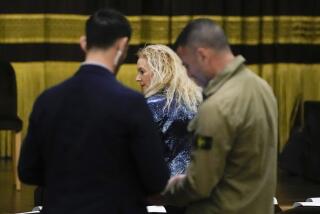Young Newcomer Carrying Stones Alone Was Latest Victim : 4 Slayings Point Out Perilous Facet of Dealing in Diamonds
- Share via
NEW YORK — In the Diamond District of Manhattan, Barbara Mangiameli was different--a young, Italian-American Catholic woman in an industry dominated by Jewish men, an outsider who went to school to gain knowledge that is often traditional.
It is not Barbara Mangiameli’s success in the diamond business, however, that its denizens will remember.
Mangiameli, 33, disappeared, along with more than $500,000 worth of diamonds, on Feb. 4, the day after a potential sale fell through. In June, her body was found in the Hudson River. She had been bludgeoned to death. Only one of the six missing stones has been recovered.
“She was just an innocent victim,” Laura Hruska, executive director of the Diamond & Jewelry Assn., said. “The lesson that has to be learned from this is that . . . you have to take care of yourself, you have to take every precaution.”
High Crime Rate
In addition to Mangiameli’s, there have been three other killings this year in the Midtown block bounded by 46th and 47th streets, Fifth Avenue and Avenue of the Americas--the heart of the Diamond District. That is a high murder rate for a business area, one police detective observed.
A walk down 47th Street, where gold-filled windows front onto rooms crowded with jewelry-laden counters, suggests the inherent risk: Gems are portable, readily negotiable and highly valuable things. The danger, one dealer said, is “an occupational hazard.”
Others say that something is wrong when a young, relatively inexperienced and unescorted woman is allowed to carry half a million dollars’ worth of stones to an unknown prospective customer. As is customary in the business, Mangiameli had only to sign memos to take the diamonds on consignment from a broker with whom she had worked before.
“This was an enormous deal and way beyond Barbara’s league,” said Debra Shapiro, Mangiameli’s friend from childhood. “If things aren’t changed it can happen again, and it will happen again.”
Born in Brooklyn and raised on Long Island, Mangiameli earned an associate’s degree in business and then worked in advertising for more than seven years. The slim, athletic brunette is remembered by friends and associates as sincere, kind, family-oriented.
In 1986, she decided to go into the jewelry business.
“She was always interested in things like archeology and gems and stones and physics,” Shapiro said.
Mangiameli started out selling what are called “findings,” jewelry parts and raw metal. When her interest turned to diamonds, she entered the Gemological Institute of America, in June, 1987, to learn about what are known in the trade as the four Cs--color, clarity, carat weight and cut. She emerged an accredited expert in the quality of diamonds and other precious stones.
She had met a broker, Charles Fischler, who became what he calls her “mentor in the diamond business.” He described her as a woman of “simple elegance,” one who wore little makeup or jewelry. Her eye, he says, was on the top.
If so, she was in the right place: Last year, 80% of the $3.4 billion worth of non-industrial diamonds that entered the United States came into New York.
Much diamond dealing is conducted in secure offices or in bourses such as the Diamond Dealers Club on West 47th Street. There, amid tight security and with the convenience of three computer systems, the men with long beards lean across narrow tables littered with pieces of waxed paper. With tweezers in hand and loupe to eye, they trade in the tiny crystals that could be worth millions of dollars.
Deals on a Handshake
It is a business based in trust. Deals are sealed and stones change hands on a handshake and the words mazel and brucha , Yiddish for “luck and blessing.” A date of payment is agreed upon and a memo is signed. Should one side renege, the dispute is referred to club arbitration.
Though she started out in sales and earned money from free-lance deals during and after her student days, Mangiameli apparently had decided that she did not belong in that part of the industry. Several times she had worked on a free-lance basis verifying gems at Christie’s, the auctioneers. She was also interviewing for a full-time job in diamond merchandising at Tiffany & Co.
Those women who make their livings in the Diamond District know well the rules of this exotic world, where a very Orthodox man will put a stone on the counter rather than risk touching a woman to whom he is not married.
The women are also well acquainted with the dangers of the business.
Barbara Laufer Shapiro, 35, runs the retail and wholesale jewelry exchange started by her father. Two years ago, her husband, Henry, 35, left the store to meet someone who owed him money. He was carrying about $6,000 worth of jewelry, she said.
Henry Shapiro’s body was found in February, 1987, in a Queens swamp. He had been shot four times, in the head and chest.
For most of Barbara Mangiameli’s short time in the business, she was not facing the risks. While in school, she began to do free-lance sales, first of finished jewelry and later of gems.
As time went on, Fischler said, she began to ask for larger and more important stones to show to clients. She continued to free-lance after her graduation in December, and on Feb. 1, Fischler said, Mangiameli called and said she had a prospective buyer for investment-quality diamonds.
At about 5:30 p.m. on Feb. 3, Fischler said, he put Mangiameli in a taxi. She was to deliver an engagement ring to a customer at 6 p.m. and then meet a diplomat from a Third World nation who supposedly was interested in the diamonds.
The meeting had been arranged through two Italian brothers who were friends of Mangiameli’s. Fischler remembers that she didn’t seem overly excited. He had given her stones worth as much as $250,000 before.
Midnight Phone Call
When he had heard nothing from her by midnight, Fischler said, he called Mangiameli’s apartment and she told him the meeting had been canceled at the last minute. Fischler and Mangiameli agreed to meet at noon the next day, when she would return the diamonds and hand over $3,500 from the sale of the engagement ring.
She called an associate of the broker’s around 11:30 a.m. and said she was on her way. She was last reported seen shortly after noon in the vestibule of her Upper East Side building.
No one has been charged in Mangiameli’s death or the theft of the diamonds, but authorities say that brothers Fausto and Raoul Rivalta, were arrested on April 11 and charged with interstate transportation of stolen property--one of the stones--and that they are suspects in Mangiameli’s disappearance.
When Mangiameli’s body was found June 9, the medical examiner’s office said she had not been dead for very long, “certainly . . . not months,” but that estimate was revised with consideration of the water temperature and other conditions.
A spokesman for the office said: “We’re still not prepared to give any information out on the timing of the death.”
Trial Set This Week
The Rivaltas have been held without bail since their arrest. Their trial is set to begin Monday in federal court in Manhattan.
The federal complaint against them alleges that, two weeks after Mangiameli disappeared, Fausto Rivalta sold a pear-shaped diamond in a Florida pawnshop for $14,000. An appraiser identified it as one of the six missing gems.
The brothers made separate statements to the Manhattan district attorney’s office in March, and each denied buying any of the diamonds shown to them by Mangiameli on Feb. 2.
Debra Shapiro said Fausto --who lived in the same apartment building as Mangiameli--described himself as an interior designer. Assistant U.S. Atty. J. Gilmore Childers said that at the time of his arrest, Fausto, 33, was on probation from a burglary charge in New York and had been arrested several times in Italy, mostly for “theft-related” crimes.
Shapiro and Fischler say they never met Raoul Rivalta, whom Mangiameli described to Fischler as a vice president of the brokerage Bear Stearns & Co. In an affidavit dated April 28, Raoul, 48, described himself as “on leave of absence” from the firm, but the company’s personnel director, Steve Lacoff, said Raoul was fired Feb. 26 after he failed to return from a vacation. He said Raoul started as a security guard in April, 1984, and had worked his way up to the post of clerk in the international operations department.
Dangerous Occupation
Some people in the Diamond District say Mangiameli should not have carried diamonds to meet someone she did not know, yet many dealers and brokers carry jewels, and danger is widely regarded as inevitable in a business that deals in some of the world’s most precious objects.
More to Read
Sign up for Essential California
The most important California stories and recommendations in your inbox every morning.
You may occasionally receive promotional content from the Los Angeles Times.









